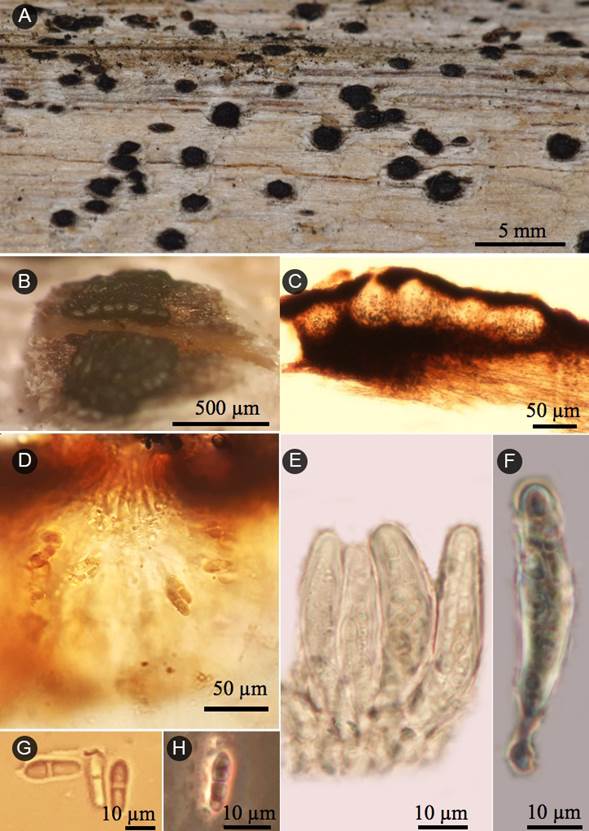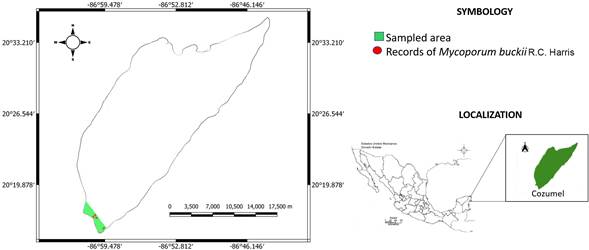Introduction
Mycoporum Flot. ex Nyl. is a monotypic genus of the family Mycoporaceae (Hyde et al., 2013) within the order Pleosporales, class Dothideomycetes. According to Index Fungorum (2020), this genus comprises 48 species, is saprobe, and not or facultatively lichenised (Nash et al., 2002). It includes species that grow on tree bark; and develops multi-loculate, scattered, aggregated, sphaerical or conical ascostromata, erumpent or superficial, black, globose to subglobose. Locules have no own wall, and open through an apical pore or an elongated channel; pseudoparaphyses are filiform, hyaline, often septate; asci are octosporate, bitunicate, fissitunicate, cylindrical to obclavate, with a short pedicel; ascospores are ellipsoidal, fusiform to clavate with a larger hemispore, variably septate; hyaline to brown; the asexual state is unknown (Aptroot, 2002; Hyde et al., 2013).
In America, 19 species of Mycoporum have been reported (Imshaug, 1956; Harris, 1995; Nash et al., 2002; Mercado-Díaz, 2009; Hodkinson, 2010; Lendemer and Harris, 2014). In Mexico, only three species in this genus are currently known: Mycoporum eschweileri (Müll. Arg.) R.C. Harris in the Sonora Desert, Baja California, Baja California Sur, Sinaloa (Aptroot, 2002) and Jalisco, and M. californicum (Zahlbr.) R.C. Harris and M. lacteum (Ach.) R.C. Harris in Jalisco (Herrera-Campos et al., 2017).
The objective of this study is to report Mycoporum buckii R.C. Harris for the first time in Mexico.
Materials and Methods
The samples were collected in mangrove forests located in the Punta Sur Ecological Park in the Cozumel Island Biosphere Reserve (20°16'41"N, 86°58'5"W and 20°18'27"N, 87°00'41"W) (Fig. 1). The climate is tropical, with an average temperature of 25 °C, and a mean annual precipitation of 1570 mm (annual maximum occurs in October with 250 mm and minimum in April with 40 mm) (INEGI, 2013). The mangrove forests are represented by the species Rhizophora mangle L., Laguncularia racemosa (L.) C.F. Gaertn., Conocarpus erectus L. and Avicennia germinans L. (Téllez-Valdez et al., 1989). The specimens were collected in May and October 2019 on R. mangle bark and were deposited in the fungal collection “Dr. Gastón Guzmán Huerta” in the Herbarium of the Escuela Nacional de Ciencias Biológicas of the Instituto Politécnico Nacional, Mexico City, Mexico (ENCB). Longitude and latitude coordinates were obtained with GPS eTrex (Garmin). Morphological examinations were conducted as outlined by Brodo et al. (2001). The morphology of the specimens was examined using a microscope Nikon eclipse 8i with an adapted camera Nikon DS-Fi1 (Nikon, Tokyo, Japan). Ascospore measurements were made in water at ×1000 magnification, and only well-developed ascospores lying outside the asci were measured.
Results
Mycoporaceae
Mycoporum buckii R.C. Harris, More Florida Lichens, Inc. 10 Cent Tour Pyrenol: 68. 1995. Figs. 2-3.

Figure 2: Mycoporum buckii R.C. Harris: A. ascostromata on bark of R. mangle; B. longitudinal section of ascomata, showing the locules; C. locules; D. individual locule, E, F. asci; G, H. ascospores.

Figure 3: Mycoporum buckii R.C. Harris: A. locules in ascostromata; B. asci with ascospores; C. ascospores.
TYPE: UNITED STATES OF AMERICA. Florida, Duval Co., Jacksonville Beach, W. R. Buck B175 (holotype: MICH, NY).
Non-lichenised; ascostromata 0.1-0.7 mm diameter, spherical, black, superficial, scattered, locules 6-12, composed of pale brown mycelium, upper wall 18-20 µm and bottom wall 40-60 µm thick; locules 50-65(73) × 40-60 μm, spherical to peritheciode, without wall of their own, immersed in the ascostroma, aggregated; ostiole forming an short apical pore, 7-11 × 13-15 µm; peridium of pseudoparenchymatous cells of variable size, brown; hymenium hyaline, gelatinous, with globose texture; pseudoparaphyses 0.5-1 μm thick, filiform, hyaline; asci 35-40 × 7-9(-12) µm, obclavate, hyaline, bitunicate, octosporated, ectotunica thin; endotunica very thick in upper half of asci, with a pedicel 6-9 × 2-3 µm; ascospores (10)10.5-12 × 2.5-3.5(5) μm, ellipsoidal, hyaline, with smooth wall, with a transversal septum, often with broader upper hemisphere, irregularly arranged in asci. Not able to grow in culture media. Asexual state not seen.
Ecology and distribution: habit saprobe, growing on dry, dead primary branches still on the living tree and dead fallen branches of Rhizophora mangle in a mangrove forest in a coastal lagoon called Laguna Colombia. The individuals of R. mangle on which M. buckii was growing were found in the upper zone of the coastal lagoon, where the level of flooding is minimum. The species was found in greater abundance in the dry season, but was able to form asci with ascospores in both dry and rainy seasons.
It was found frequently growing together with the non-lichenised fungus Naevia pinastri (Anzi) Thiyagaraja, Lücking & K.D. Hyde.
Mycoporum buckii has been reported in the United States of America in a floodplain in Florida and in the Dominican Republic in El Morro de Monte Cristi in low dry forest near the sea (CNALH, 2020). Our discovery thus is a new record for Mexico.
Specimens studied: MEXICO. Quintana Roo, municipality Cozumel, Punta sur, 20°16'48''N, 86°58'44''W, 0 m, 19.V.2019, Y. A. García and M. A. Bravo 40 (ENCB), 42 (ENCB), 43 (ENCB); loc. cit., 20°17'57''N, 86°60'14''W, 0 m, Y. A. García and M. A. Bravo 51 (ENCB), 57 (ENCB), 60 (ENCB); loc. cit., 20°18'00''N, 86°60'14''W, 7 m, 16.X.2019, T. Raymundo 8321b (ENCB), Y. A. García and M. A. Bravo 70 (ENCB), 73 (ENCB).
Discussion
Mycoporum buckii is characterised by its black ascomata, superficial with locules 50-100 × 40-60 µm, asci oboclavate with a short pedicel 6-9 × 2-3 µm, ascospores 10-13 × 2.5-3.5 µm with one transversal septum (Figs. 2, 3). Mycoporum is a genus reported as facultative-lichenised (Thiyagarja et al., 2020) and Harris (1995) reports M. buckii as lichenised species. We observed a whitening bark where M. buckii was growing; however, during the microscopic examination, it was not proven that this was caused by thallus formation, thus we report it as a non-lichenised species.
According to Harris (1995), this species has been found associated with Taxodium Rich. and Quercus L. in Florida (USA) and in flood plain forest and vegetation near the sea in Dominican Republic. Therefore, it can be considered that M. buckii is a species that is distributed near bodies of fresh and salt or brackish water, as was the case in this study, where it was found in mangrove forests. So far, M. buckii has only been recorded for the American continent.
Mycoporum eschweileri is a species similar to M. buckii due to the characteristics of the ascostroma, the multilocular condition and the tropical distribution. However, the shape of the asci is different since in M. eschweileri they have a pyriform shape, are 50-60 µm in length, and the ascospores are larger, 17-25 × 5-8 µm. Mycoporum antecellens (Nyl.) R.C. Harris is a species with spores similar in shape and septum, but larger in size (Table 1) (Nash et al., 2002).
Table 1: Comparison of Mycoporum antecellens (Nyl.) R.C. Harris, Mycoporum buckii R.C. Harris and Mycoporum eschweileri R.C. Harris.
| M. antecellens (Nyl.) R.C. Harris | M. buckii R.C. Harris | M. eschweileri (Müll) R.C. Harris | |
| Ascostroma size (mm) | 0.2-0.3 | 0.1-0.7 | 0.4-0.7 |
| Locule size (μm) | Not specified | 50-65 (73) × 40-60 | Not specified |
| Asci size (µm) | 60-70 ×18-22 | 35-40 × 7-9 (-12) | 50-60 × 15-20 |
| Asci form | Pyriform | Obclavate | Pyriform |
| Ascospore size (µm) | 25-30 × 6-9 | (10) 10.5-12 × 2.5-3.5 (5) | 17-25 × 5-8 |
| Number of ascospores septa | 1-3 | 1 | 1 |
| Distribution | Wide distribution | Dominican Republic, Mexico, USA | Pantropical |











 nova página do texto(beta)
nova página do texto(beta)




